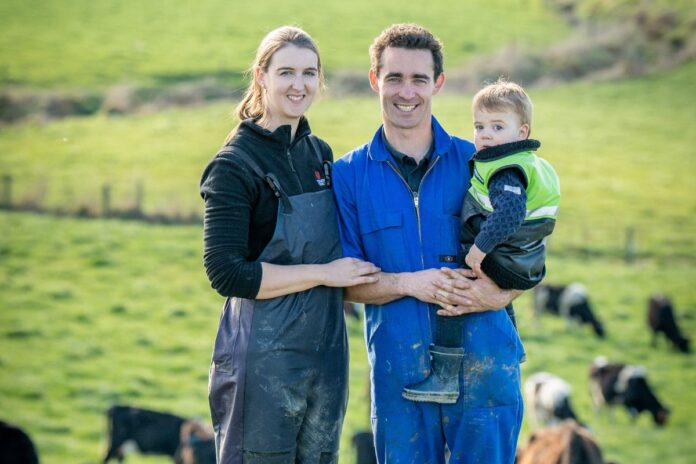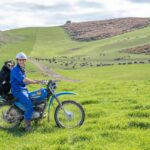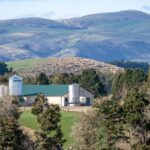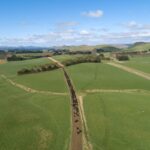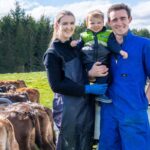Dairy Farming in New Zealand
That’s Farming editor, Catherina Cunnane, in conversation with Ollie & Lauren Badcock, Gore, South Islan, New Zealand of Nithdale Dairies, in this week’s dairy farming segment.
Ollie hails from a beef and arable farm and secured his first job dairying when he was 16, while Lauren grew up a townie with no connection to farming until she met Ollie.
She studied law at the University of Gloucestershire and began dairy farming alongside Ollie in their first season in New Zealand.
“The farm, which spans 280ha, is owned by Andrew and Heather Tripp and share milked by us.
We milk 850 cows at peak and always winter around the 870 mark, as it brings us to a stocking rate of 3 cows to the hectare.
We are in a dry part of southland, which is high enough when we hit a dry spell. Our main focus is around per cow production over the number of cows.
We run a spring-calving grass-based system with crossbreds, with all cows wintered on kale and Swedes on the property.
We have a 10-week mating season, and calving starts on August 10th with a system to front-load the heifers that are AI bred.
220 heifer replacements are reared with a further 100 Hereford-cross calves to run across Nithdale Station, which comprises sheep and beef, and dairy grazing across 1600ha.
The station supports the dairy farm, so we winter the cows and graze youngstock there.
Grass is measured weekly on the dairy farm to manage surplus and deficit throughout the season, as it is a huge focus to utilise as much grass as possible.
Dairy farming in New Zealand
Cows will produce 440kg/MS/cow this year, which is 96% of body weight, a big KPI we are focusing on.
We are aiming for that 1:1, if not more. We will grow 15.5t/DM/ha with a big focus on reseeding 10% of the farm to try and increase dry matter grown as well as protection through the dry summers.
As variable order share milkers, we get 21% of the payout and have to supply all the labour, electricity, tractor, feeding equipment, mower, diesel, chemical, and rubber wear.
A lot of our costs are variable, which means we have to keep a strict budget when operating on a day-to-day basis.
We run a team of 5 during calving, including us, and then 3 for the rest of the season. Since the reopening of the borders, we have been able to have English and Irish farmers coming across to learn the NZ farming systems.
Our favourite thing about dairy farming is the lifestyle; bringing up our young family here is so enjoyable.
Besides, you can go weeks through different parts of the season; for instance, mating, it feels like a marathon day in day out and when it comes to scanning and, you get a really good result.
It is in these challenging times that you learn and grow the most from.
Challenges
For us, challenges include a prolonged dry summer, a weather event, an accident on-farm, being burnt out during the spring, and the distance between our families while having a young child.
It is in these times of adversity is where we have found the most challenging times, but the trend is that you grow the most in these times too.
Our biggest challenge to overcome since farming was when Ollie had a motorbike accident on-farm which saw him shatter his tibia and fibula.
It was week two of calving, and due to complications, that almost resulted in him losing his leg and living quite rurally, Ollie had to be in hospital for over ten days.
The toll of working all day and driving to the hospital two hours away in the evenings was extremely wearing.
With it being Lauren’s first season on the farm, it was down to the owner to teach me all he knew.
It was a baptism of fire, and I learnt a lot and have never looked back in farming since.
We still face a number of problems through, government and compliance, weather, and dry summers like everyone else. What we work on is what we can control and impacts us on-farm.
So by, making sure our summer dry and winter policies are followed shows that we have contingency plans in place when adverse weather does come.
Farming in NZ & the UK
Farming is very similar here in New Zealand, compared to the UK in many ways. KPIs of your farm/business are still measured.
What we do find different is the avenues we can take to grow, moving our way up the ladder.
That may be rearing extra calves to introduce into the herd or selling as surplus to lease ground to run stock on, or even the whole contract milking share milking system that you can operate under your business with minimal overheads all the way to building equity in cows, all of which can be done because of size, space and opportunity.
Progression in the dairy industry is what attracted us to NZ. The whole grow pathway was tried and tested and easily seen nationwide.
This is something that was very different at home in the UK, with family farms getting smaller and corporate farms taking over more rentable ground, preventing the growth of the younger generation.
Future
Short-term, our plan is to buy the herd from the owner within the next four years to become 50/50 share milkers, and our long-term goal is to own our own farm in the next ten years.
The plan is to get more efficient and cull out the cows that are not doing their body weight in milk solids. We have no plans to increase numbers; just focus on pushing our per cow/ms.
360,000kg/ms is the target this season, and we are currently on track to do record production, so to build on that and increase it year on year.
Our outlook for dairy farming is positive; the growth in the market is still steady and will continue.
The opportunity we see in farming is huge. If we can farm better, more efficiently, and with fewer or similar resources, then we are doing well.
We want to embrace change and see it as an opportunity to do better. We are keepers of the land and want to leave it in a better state than what we found it in for the next generation of farmers.
Reflection
We emigrated from Cornwall, UK, to South Island, New Zealand, where we managed for three seasons and alongside managing, we were rearing our own stock on a runoff block.
Then, we gained our residency, which allowed us to move up the dairy industry ladder and go contract milking, where we started milking our own cows.
We sold all of our stock to take a lower-order share milking job with 870 cows which gives us the opportunity to buy the cows on the farm.
Looking back over the past five years and thinking about our measure of success, it is celebrating the wins along the way.
Our end goal of farm ownership will be where we set it, but we are enjoying the journey to get there.”
To share your story, email – [email protected]


